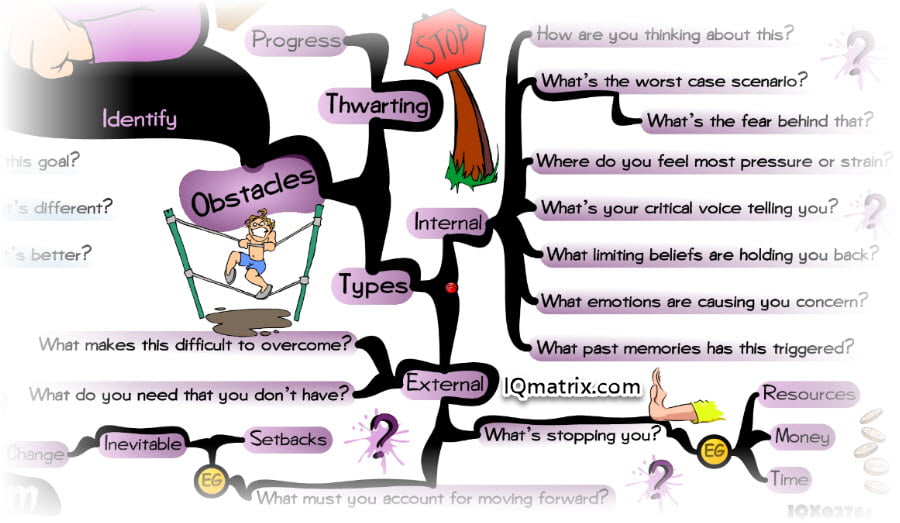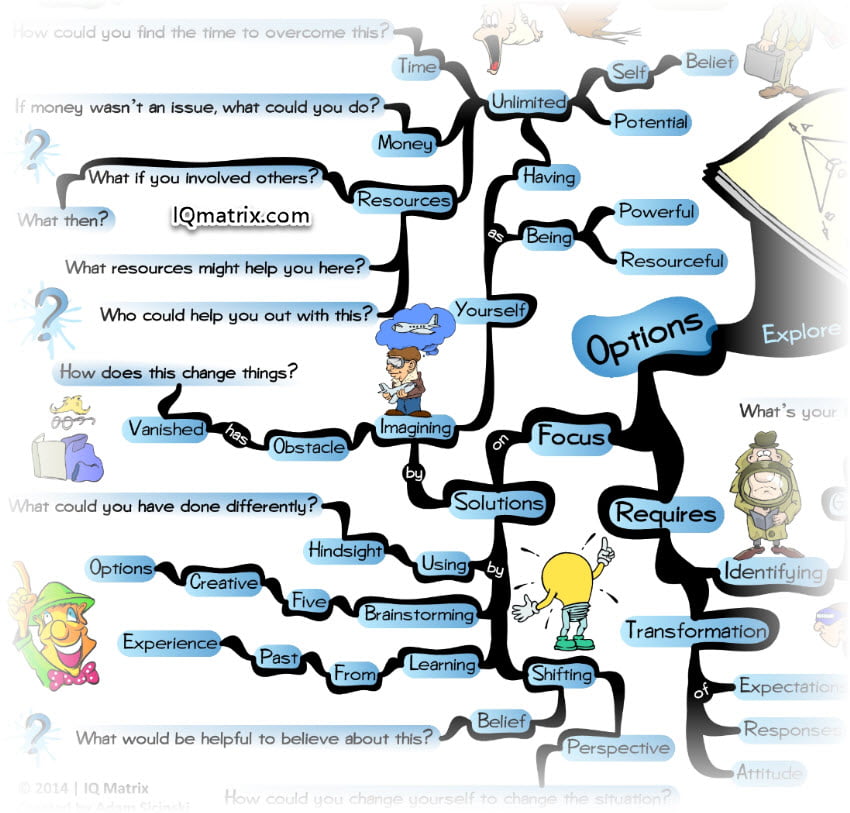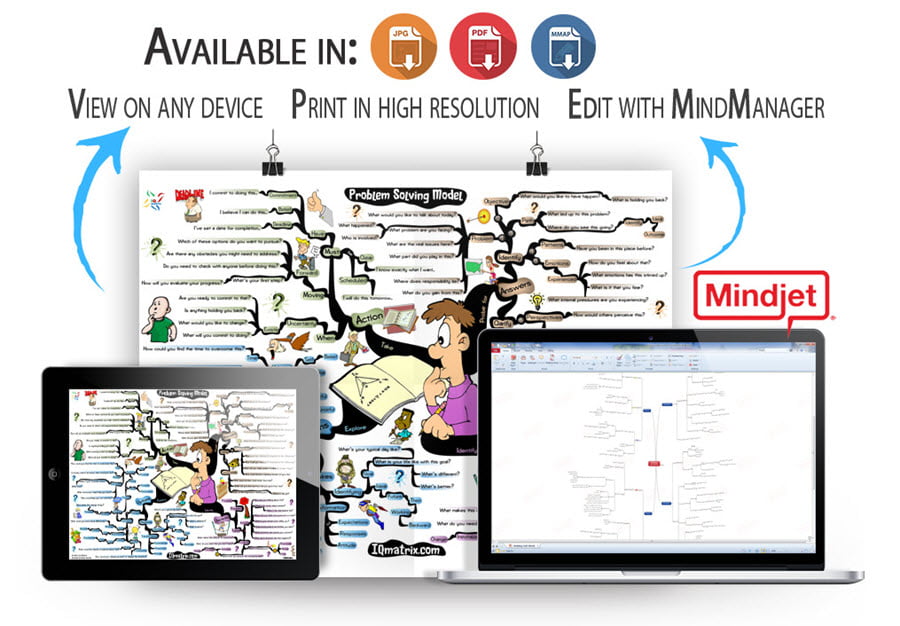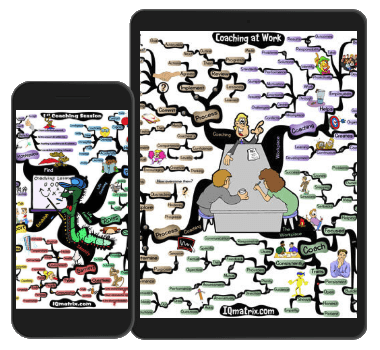It is tempting, if the only tool you have is a hammer, to treat everything as if it were a nail. – Abraham Maslow
This article is part of a series of five articles that walk you through various questioning methods and models typically used for life coaching purposes. However, these questions can also be used for self-coaching purposes to help you gather more insights about your life, problems, and circumstances.
Here is a list of all articles included in this series:
- The GROW Model
- The Life Coaching Wheel
- The Life Coaching Funnel
- The Problem Solving Model
- The Decision Making Model
Helping Your Client Solve a Problem
As a life coach, one of our main objectives is to help guide a client from Point A to Point B in the most optimal way possible. Furthermore, it’s all about helping them become more resourceful in every situation, thereby assisting them to make more effective decisions about their life, problems, and circumstances.
Typically, a client will hire a life coach because they are feeling dissatisfied with an aspect of their life. They either feel as though they are not living up to their full potential, or are struggling to overcome some kind of problem or emotional roadblock.
For the purpose of this article, let’s take a look at problem-solving and how you as a life coach can help your client work through a problem in an effective and optimal way using a series of steps and questions.
The process that we will discuss here is known as the Life Coaching Problem Solving Model. You can use this model whenever a client faces a problem. This model will help you to take your client through a series of steps and questions that will provide them with tremendous clarity about the problem they are dealing with. Moreover, it will allow them to work through this problem in the most optimal way possible.
Along this journey, you will, of course, be their guide. You will guide them through each step and therefore need to be flexible in your approach. The list of steps and questions that follow are there to guide you as a life coach through this model, however, it’s also important to adapt your approach depending on the answers that your client gives you at each stage of this process.
With all this in mind, you can of course skip steps and refrain from asking certain questions. This is perfectly fine. No matter how you choose to use this model it’s important that in the end your client feels empowered to take positive action toward resolving their problem. If there is any hesitancy then you simply need to go back and try to be a little more thorough in your approach. Only in this way will you help lay down the foundations for successful problem-solving.
Begin by Probing for Answers
Your first objective when working through the Life Coaching Problem Solving Model is to simply probe for answers.
Your client comes to you with a problem or challenge that they are struggling to work through. Your task is to ask them some key questions that help provide the both of you some clarity about the nature of the problem. To do this you will need to ask them several probing questions that:
- Explore the problem.
- Explore how they feel and perceive this problem.
- Explore the path they would like to take moving forward.
Let’s now take a look at the questions you might want to ask here that help you address the above-mentioned areas.
Question the Problem
Within this first set of questions, your objective is to get an understanding of the nature of the problem. Ask your client the following questions:
What would you like to talk about today?
What kind of problem are you facing?
What happened exactly? Who is involved?
What led up to this problem?
What part did you play in the formation of this problem?
What are the real issues here that you would like to deal with?
Have you been in this position before?
Where do you feel that responsibility lies?
Hypothetically, what do you gain from all this?
The final question puts a little spin on the problem. It gets your client thinking about the nature of this problem and how it could potentially work to their advantage. It’s, of course, possible that your client might be in a very negative state-of-mind and therefore finding value within their problem may be difficult at this time. However, don’t let that stop you from asking this question. Solutions will only be found when your client is able to see the light at the end of the tunnel.
Question Your Client’s Emotional State
Your next task is to question your client’s emotional state. In other words, get a sense for how they feel about this problem. Ask the following questions:
How do you feel about all this?
What specific emotions has this problem stirred up?
What is it that you fear will happen?
Are you feeling any internal pressure or turmoil about this?
What internal pressures or turmoil are you experiencing right now?
Understanding how your client feels about the problem helps you get a better sense of their emotional state-of-mind. Furthermore, it provides you insights into how resourceful your client might be in this situation and how ready and able they are to work through this problem successfully.
Question Your Client’s Objective
Your next task is to get a sense of what exactly your client would like to achieve. In other words, what would they ideally like to see happen to resolve this problem? Ask the following set of questions:
Where do you see all this going?
Ideally, what would you like to see happen here?
What specifically would you like to change or improve?
What is currently holding you back from bringing this to fruition?
We will discuss obstacles in detail a little later along this process. However, it is worth bringing to mind what might potentially be holding your client back from making their desired changes. Make a note of the specific roadblocks they mention here and bring them up a little later along this process.
Question Your Client’s Perspective
It’s now time to start making a gradual shift in how your client perceives this problem. This is important because they will only come up with adequate solutions when they are in a more receptive and resourceful state-of-mind that is open to the possibilities that lie ahead.
The following set of questions allow you to begin helping your client make this shift in a gradual and progressive way. Ask your client:
How would others potentially perceive this problem?
Who specifically in your life would see this problem as being of value?
Why do you feel that they would perceive things in this way?
How could you choose to respond to this problem differently?
How could you choose to experience this problem differently?
How can you make peace with parts of this problem that you might not be able to change or work through?
What opportunities could potentially result from all this?
What can you learn and how can you potentially grow from this experience?
What specifically might this experience be teaching you? Where is the gift?
How could getting through this problem become a defining moment in your life?
These last set of questions should now put your client into a more optimal state-of-mind. What this essentially means is that your client should now feel more resourceful and capable of working through this problem.
Identifying Potential Obstacles
The above questions have no doubt laid down a solid foundation, however, no matter how great your client may feel, this all typically falls apart the moment they face an unexpected obstacle that completely derails their efforts.
In order to avoid this kind of scenario, it’s important to now progressively work through some internal and external obstacles they may face along their journey that could potentially thwart their progress.
Highlighting these obstacles is of course important because it will allow your client to prepare for them in both a physical and mental capacity. As a result, they will be more capable and more resourceful when facing these potential roadblocks in the future.
Internal Obstacles
Internal obstacles are mental and emotional roadblocks that prevent us from moving forward. These obstacles can, of course, be difficult to overcome, however, they are typically within our control, which makes it a great place for starting the questioning process. Ask your client:
How are you thinking about this problem?
What’s the worst-case scenario that you can imagine will happen?
What’s the fear that lies behind all this?
Where do you feel most pressure or strain when it comes to this problem?
What’s your critical voice telling you?
What limiting beliefs do you feel are holding you back at this moment?
What specific emotions are causing you some concern?
What past memories of mistakes and failure has this problem triggered?
Asking these questions will highlight several internal roadblocks that your client might need to work through. This is where you may potentially want to work through limiting beliefs, unresourceful emotions, unhelpful thoughts, fears, and past memories of mistakes and failure that might be holding your client back.
How much attention you give to each area depends on where you feel your client is at. Potentially you may need to divert away from the Life Coaching Problem Solving Model in order to work through, for instance, some limiting beliefs or unhelpful thoughts that your client is struggling with. Only once these mental roadblocks have been removed, will your client be free to move forward toward solving this problem.
External Obstacles
External obstacles are things that aren’t always within our own personal control. For instance, we might not have enough time, money, support, skills, experience, knowledge or other resources. Yes, all these things can, of course, be classified under the category of “poor excuses“. It is, however, important to address these areas, and then potentially try and reframe how your client perceives these limitations.
The goal at this stage is to empower your client. It’s to get them thinking about possibilities rather than roadblocks. It’s about helping them to become more resourceful so that they can successfully handle the problem at hand.
With this in mind, ask your client the following set of questions:
What specifically makes this problem difficult to overcome?
What specifically is stopping you right now from moving forward?
What do you need that you don’t believe you currently have on hand to help you get through this?
What must you potentially account for moving forward?
What inevitable changes might you need to make?
What setbacks could you potentially face?
What form do these roadblocks take? For instance is it people, specific things or situations?
Which of these variables are under your direct control?
Which of these variables are not quite within your control?
How do you endeavor to handle yourself in these situations?
Having identified all the potential roadblocks that might prevent your client from moving forward, it’s now time to explore potential options and then to draw out an action plan for overcoming this problem.
Explore Potential Options Moving Forward
One of the main reasons your client has possibly struggled to overcome their problem is because of a lack of options. They simply don’t quite know what to do. But of course, this doesn’t mean that they are not capable of successfully moving through this. They are simply lacking the necessary perspective that would help them work through this problem in an optimal way.
Your objective at this stage of the Life Coaching Problem Solving Model is to help empower your client to find suitable options for moving through this problem. To do this you first need to clarify the goal that they would like to achieve. Ask them:
What would you like to achieve in this situation?
What is your life like having achieved this goal?
What is your life like when this is no longer a problem?
What’s your typical day like in this situation?
What’s specifically different? What’s potentially better?
What you’re trying to do here is to get your client excited about an ideal future that they envision where they no longer need to deal with this problem.
With this ideal future in mind, you can then potentially work backward from this optimal experience all the way back to the solution and the implementation of the idea. This is known as the process of Reverse Engineering where you are working from an end goal and moving backward step-by-step until you reach the present moment. It’s certainly a helpful process, but it might not be enough.
What your client needs is to feel empowered. And to feel empowered you must address the following areas:
- Build their self-belief.
- Strengthen their self-confidence.
- Shift their understanding of themselves in relation to their problem.
- Help them become more resourceful.
- Transform their attitude and perspective.
- Transform their expectations about the situation.
Here are several questions that will potentially help address the above-mentioned areas.
What would it be helpful to believe about this?
What would it be helpful to believe about yourself? About the situation? About your ability to work through this successfully?
What would it be helpful to expect of yourself when handling this problem?
What past experiences could potentially serve you in this situation?
How could you change yourself to potentially change your situation and overcome this problem? What exactly would you need to change?
If you could do this all over again, what could you have done differently in that instance?
What if you had an unlimited amount of time? How would you tackle this problem?
If money was no longer an issue, what could you potentially do about this?
What if you had unlimited ability and resources to handle this successfully? What would you do?
What if you involved others? What would happen? How could you potentially solve this problem?
Who specifically could potentially help you out with this?
What other resources might be of value in this situation to help you solve this problem?
What if all the obstacles you faced suddenly vanished? How would that change things? What would you now think and do?
Imagine for a moment that you knew exactly what you were doing here to solve this problem. What five creative options could you come up with?
Progressively working through these questions in this way will typically help your client feel more empowered, resourceful and capable. Moreover, they should also manage to come up with several options for working through their problem. And that’s precisely what you’re looking for. You’re trying to encourage them to come up with their own answers and solutions.
The key here is that your client must take ownership of their problem and of the solutions they bring to mind. They must take responsibility for not only their predicament but also for successfully working through their predicament. You are only there as a guide and supporter. Moreover, you are there as an accountability partner. And this becomes vital as we move into the final stage of the Life Coaching Problem Solving Model.
Taking Proactive Action to Solve the Problem
The final stage of the Life Coaching Problem Solving Model requires getting your client fully committed and onboard toward taking proactive action in the direction of their goal.
Within the previous stage, they outlined several options that they could potentially take moving forward. It’s time now to review these options in order to determine which specific option to pursue. Ask your client the following questions:
Which of these options do you want to pursue?
Are there any obstacles that you might need to address at this time?
Do you need to check with anyone before doing this?
What’s your first step moving forward?
How will you know you’re on target?
How specifically will you evaluate your progress?
As you work through these questions it’s vital that you are certain that your client is clear and knows exactly what they will be doing. Moreover, they need to understand and commit to doing things on schedule. And this is of course where you can help them outline an appropriate plan of action that will help them to achieve their goal.
There will, of course, be uncertainty along this journey. With uncertainty comes self-doubt and a plethora of emotions that might prevent your client from moving forward. As such, it’s helpful to spend a little bit of time questioning these uncertainties in the following way:
What if things don’t go to plan or as you had expected?
Will you still commit to following through with your plan of action?
How will you potentially adapt your approach?
Could anything potentially hold you back?
Given this, what would you like to change in order to get through this?
What specifically will you now commit to doing when uncertainties arise?
In the end there must be three elements in place before you end your session and give your client the green light to move forward with their plan of action. These things are Commitment, Belief and a Clear Deadline.
At the conclusion of the session there must be no doubt in your client’s mind that they can stand by the following statements:
- “I fully commit to doing this…”
- “I believe that I can do this…”
- “I’ve set a date for completion and am ready to take action…”
As a life coach, it’s then up to you to hold them accountable and make sure they stay on track working toward their goal. It will of course often be a journey of ups and downs, but that’s simply a part of the process. Your client must learn to dig deep within themselves and become more resourceful when adversity strikes. You will, of course, be there to guide and support them along the way, helping them find an optimal path moving forward.
Time to Assimilate these Concepts
Did you gain value from this article? Is it important that you know and understand this topic? Would you like to optimize how you think about this topic? Would you like a method for applying these ideas to your life?
If you answered yes to any of these questions, then I’m confident you will gain tremendous value from using the accompanying IQ Matrix for coaching or self-coaching purposes. This mind map provides you with a quick visual overview of the article you just read. The branches, interlinking ideas, and images model how the brain thinks and processes information. It’s kind of like implanting a thought into your brain – an upgrade of sorts that optimizes how you think about these concepts and ideas. 🙂
Recommended IQ Matrix Bundles
If you’re intrigued by the idea of using mind maps for self-improvement then I would like to invite you to become an IQ Matrix Member.
If you’re new to mind mapping or just want to check things out, then register for the Free 12 Month Membership Program. There you will gain access to over 90 mind maps, visual tools, and resources valued at over $500.
If, on the other hand, you want access to an ever-growing library of 100s of visual tools and resources, then check out our Premium Membership Packages. These packages provide you with the ultimate visual reference library for all your personal development needs.
Gain More Knowledge…
Here are some additional links and resources that will help you learn more about this topic:
- 5 Steps for Solving Problems with Your Problem Solving @ Inc.
- 5 Whys: Getting to the Root of the Problem Quickly @ MindTools
- 8D Problem Solving Process: Solving Major Problems in a Disciplined Way @ MindTools
- How to Solve a Problem @ WikiHow
- How to Solve a Problem: 6 Quick and Powerful Tips @ Positivity Blog
- Hurson’s Productive Thinking Model: Solving Problems Creatively @ MindTools
- The 4 Most Effective Ways Leaders Solve Problems @ Forbes
- The 10 Step Process for Solving Any Problem @ Brian Tracy International
- The Six Step Problem Solving Model (pdf) @ Yale
- The Straw Man Concept for Solving Problems @ MindTools
- Who, What and How? A Simple Problem Solving Model @ Inc.









